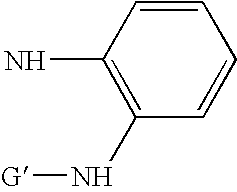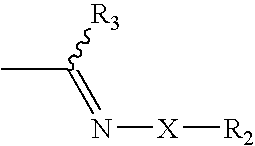Cinnamic, phenylpropiolic and phenylpropanoic acid derivatives useful as anti-tumor agents
a technology of phenylpropiolic acid and cinnamic acid, which is applied in the direction of heterocyclic compound active ingredients, drug compositions, biocides, etc., can solve the problems of reducing the long-term efficacy of therapy, inability to eliminate primary tumours by surgery, and inability to achieve anti-neoplastic treatment in the long term
- Summary
- Abstract
- Description
- Claims
- Application Information
AI Technical Summary
Benefits of technology
Problems solved by technology
Method used
Image
Examples
example 1
Preparation of (2E)-N-hydroxy-3-(4-{[(allyloxy)imino]methyl}phenyl)acrylamide (ST2984)
[0148]Step 1: a solution of trans 4-formyl-cinnamic acid A (Y═CH═CH, R1, ═H, R3═H, 0.346 g, 1.96 mmol.) and B O-Allylhydroxylamine hydrochloride (0.258 g, 2.37 mmol.) dissolved in 2 mL of DMF was warmed at 50° C. and stirred for 5 h. Then the solution was diluted with AcOEt and washed with water. Organic layer was dried on Na2SO4 and then concentrated under reduced pressure to give 0.421 g of the intermediate C (2E)-3-(4-{[(benzyloxy)imino]methyl}phenyl)acrylic acid (93% yield).
[0149]MS (ESI) m / z: [M−1]−=230.3
[0150]Step 2: in a flask intermediate C obtained from step 1 (0.123 g, 0.53 mmol) was dissolved in 1.5 mL of DMF together with HATU (0.222 g, 0.58 mmol) and DIEA (185 μL, 1.06 mmol). After 0.5 h, a solution of hydroxylamine as hydrochloride salt (0.055 g, 0.80 mmol) and DIEA (139 μL, 0.80 mmol) in 1.5 mL of DMF was added. The mixture was stirred at room temperature for 24 h and then diluted wi...
example 2
Preparation of (2E)-N-hydroxy-3-{4-[(phenoxyimino)methyl]phenyl}acrylamide (ST2985)
[0155]Step 1: intermediate C (2E)-3-{4-[(phenoxyimino)methyl]phenyl}acrylic acid for the synthesis of ST2985 was obtained (0.520 g, 99% yield) as described in step 1, example 1, starting from trans 4-formyl-cinnamic acid A (0.342 g, 1.94 mmol) and B O-Phenylhydroxylamine hydrochloride (0.339 g, 2.33 mmol).
[0156]MS (ESI) m / z: [M−1]−=266.4
[0157]Step 2: compound ST2985 was obtained (0.100 g, 48% yield) as described in step 2, example 1, starting from intermediate C (0.201 g, 0.75 mmol).
[0158]MS (ESI) m / z: [M−1]−=281.1
[0159][M+23]+=305.0
[0160]1H-NMR (200 MHz, DMSO-d6) δ (ppm): 6.5-6.7 (d, J=15.7 Hz, 1H, CH), 7.0-7.1 (t, J=6.9 Hz, 1H, CHar), 7.2-7.3 (d, J=8.0 Hz, 2H, 2×CHar), 7.3-7.4 (t, J=7.3 Hz, 2H, 2×CHar), 7.4-7.6 (d, J=16.1 Hz, 1H, CH), 7.6-7.7 (d, J=7.7 Hz, 2H, 2×CHar), 7.8-7.9 (d, J=7.7 Hz, 2H, 2×CHar), 8.7 (s, 1H, CH), 9.1 (bs, 1H, NH), 10.8 (bs, 1H, OH).
[0161]13C-NMR (50 MHz, DMSO-d6) δ (ppm): 115...
example 3
Preparation of (2E)-N-hydroxy-3-[4-({[(4-nitrobenzyl)oxy]imino}-methyl)phenyl]acrylamide (ST2987)
[0162]Step 1: intermediate C (2E)-3-[4-({[(4-nitrobenzyl)oxy]imino}-methyl)phenyl]acrylic acid (ST3075) for the synthesis of ST2987 was obtained (0.610 g, 94% yield) as described in step 1, example 1, starting from trans 4-formyl-cinnamic acid A (0.348 g, 1.97 mmol) and B O-(4-Nitrobenzyl)hydroxylamine hydrochloride (0.485 g, 2.37 mmol).
[0163]MS (ESI) m / z: [M−1]−=325.3
[0164]1H-NMR (200 MHz, DMSO-d6) δ (ppm): 5.34 (s, 2H, CH2), 6.5-6.7 (d, J=15.7 Hz, 1H, CH), 7.5-7.8 (m, 7H, 6×CHar, CH), 8.2-8.3 (d, J=8.4 Hz, 2H, 2×CHar), 8.41 (s, 1H, CH), 12.4 (bs, 1H, OH).
[0165]13C-NMR (50 MHz, DMSO-d6, δ): 75.0, 121.0, 124.3, 128.1, 129.4, 129.5, 133.8, 136.7, 143.7, 146.5, 147.7, 150.3, 168.2.
[0166]Step 2: compound ST2987 was obtained (0.120 g, 44% Yield) as described in step 2, example 1, starting from intermediate C (0.262 g, 0.80 mmol).
[0167]MS (ESI) m / z: [M−1]−=340.2
[0168][M+23]+=364.4
[0169]1H-NMR...
PUM
| Property | Measurement | Unit |
|---|---|---|
| temperatures | aaaaa | aaaaa |
| temperatures | aaaaa | aaaaa |
| pressure | aaaaa | aaaaa |
Abstract
Description
Claims
Application Information
 Login to View More
Login to View More - R&D
- Intellectual Property
- Life Sciences
- Materials
- Tech Scout
- Unparalleled Data Quality
- Higher Quality Content
- 60% Fewer Hallucinations
Browse by: Latest US Patents, China's latest patents, Technical Efficacy Thesaurus, Application Domain, Technology Topic, Popular Technical Reports.
© 2025 PatSnap. All rights reserved.Legal|Privacy policy|Modern Slavery Act Transparency Statement|Sitemap|About US| Contact US: help@patsnap.com



